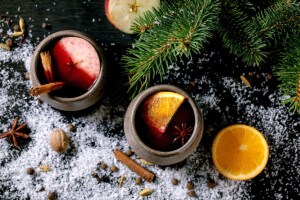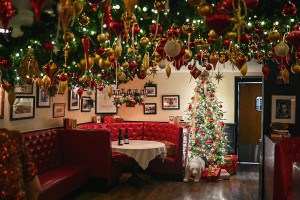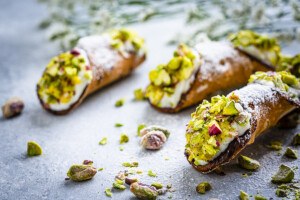New England’s Winemakers Don’t Care How They Do It in California
Funky, tart, and unlike anything made in Napa, New England’s new natural wines are changing the tastes of a generation. Don’t believe it? You must be over 40.

Photo by Pat Piasecki
On a crisp September day, I harvested grapes at a vineyard that’s broken all the rules. Most others I’ve walked through are maintained with such an intense program of pesticides, herbicides, fungicides, and tilling that they leave nothing living in their wake, save for the vines themselves. This one, however, couldn’t have been more different. The aisles were shaggy with grasses. A riot of white asters poked up beneath the vines themselves. Clouds of insects came and went. None of this bothered the vines, which were dripping fruit. Named for the red-winged blackbirds who favor the spot, Les Carouges is being farmed biodynamically—a chemical-free method of holistic management popularized by small European winemakers.
Beyond me, the vineyard gave way to quilted fields and forests framed by a wall of craggy peaks in the distance. Everything about the place—the lush green landscape, the name, the practices, and even the quality of the wine that vintner Deirdre Heekin produces with these grapes—reminded me of Europe. But the weathered red barn sporting a huge American flag at one end of the rows quickly snapped me back to reality: This was not Europe. It wasn’t even California, where most high-end American wine is made. It was Vermont. And two things that I, a lifelong Vermonter, thought I knew about my home state were that one, you can’t grow grapes organically here or anywhere else in New England—too wet, too cold—and two, the kind of grapes that can be grown here are incapable of producing great wine.
That, however, was before Heekin’s label, La Garagista, appeared on the market and dispelled some entrenched myths about how and where good wine could be made in the United States. For starters, the grapes she uses—hybrids with names like Marquette, La Crescent, and Frontenac Gris, made by crossing European wine grapes with native American species, which are the only ones that will grow in Vermont—were once the laughingstock of the wine world. She farms without the pesticides, herbicides, fungicides, and tilling that are de rigueur in the industry. When she processes the grapes into wine, she also eschews the machinery, chemical additives, preservatives, and added yeasts that are used to make the conventional wines that have dominated the market for decades. The result of such unorthodox practices? Just a few years after Heekin planted her first vine, bottles of La Garagista could be found on the wine lists of top restaurants in London, Los Angeles, New York, and Boston, and today they’re fought over by wine shops, which quickly sell out of any bottles they can get their hands on.
If the success of Heekin’s label has drawn the gaze of the wine cognoscenti to a part of the country to which it has scarcely looked before, it’s also encouraged other pioneers to do what was once thought impossible. Since La Garagista launched, three more renowned Vermont labels have started producing highly acclaimed natural wines, and the movement is spreading to other parts of New England.
Several factors have conspired to allow this spectacularly unlikely place to produce spectacular wine. From organic vegetables to handmade furniture, consumers are seeking products that are authentic, natural, and healthy—adjectives Vermont has made a brand out of—and wine is no longer an exception. Meanwhile, a cultural shift in taste preferences is under way. For the past four decades, consumers have prized the big, rich, high-alcohol wines that California is so good at producing. Yet younger drinkers increasingly favor bottles that are fresher, racier, lighter, and more tart—which, it turns out, is precisely the stuff that the cooler, wetter climate of New England is so good at producing.
Not everyone likes natural wines, of course, and the rise of these labels is dividing the wine world, shattering decades of loose consensus about what constitutes a good bottle. Critics see it as a perversion of the craft, an offense to the palate, and a threat to tradition. Or, as one old-school wine rep put it when I asked him what he thought of La Garagista wines: “They’re fine…if you like the bouquet of a donkey’s ass.”
That defensiveness, of course, is an old story, played out in countless realms of taste and fashion: A certain style dominates, until it starts to seem tired and out of step with the times, much to the chagrin of its original champions. As tastes change, hot-climate regions such as California that make big cabernets and buttery chardonnays may find themselves deeply uncool.
All of which means that New England has the potential to become an important wine region with the power to threaten the established order and help change the very definition of fine wine. In fact, from what I found in the vineyards and wine bars across the region this fall, it already is.
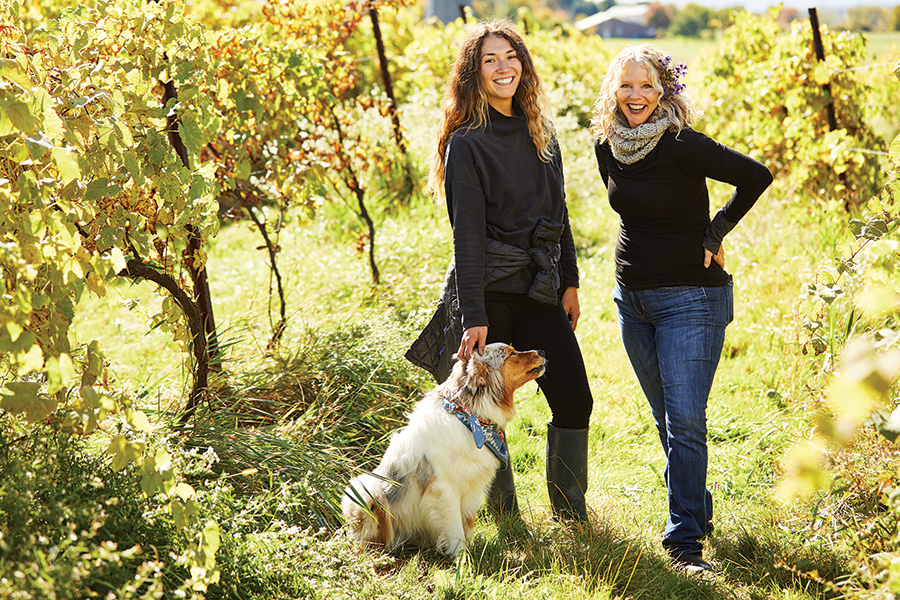
Scenes from the making of La Garagista natural wines, crafted by acclaimed vintner Deirdre Heekin (at right) in Vermont. / Photo by Pat Piasecki
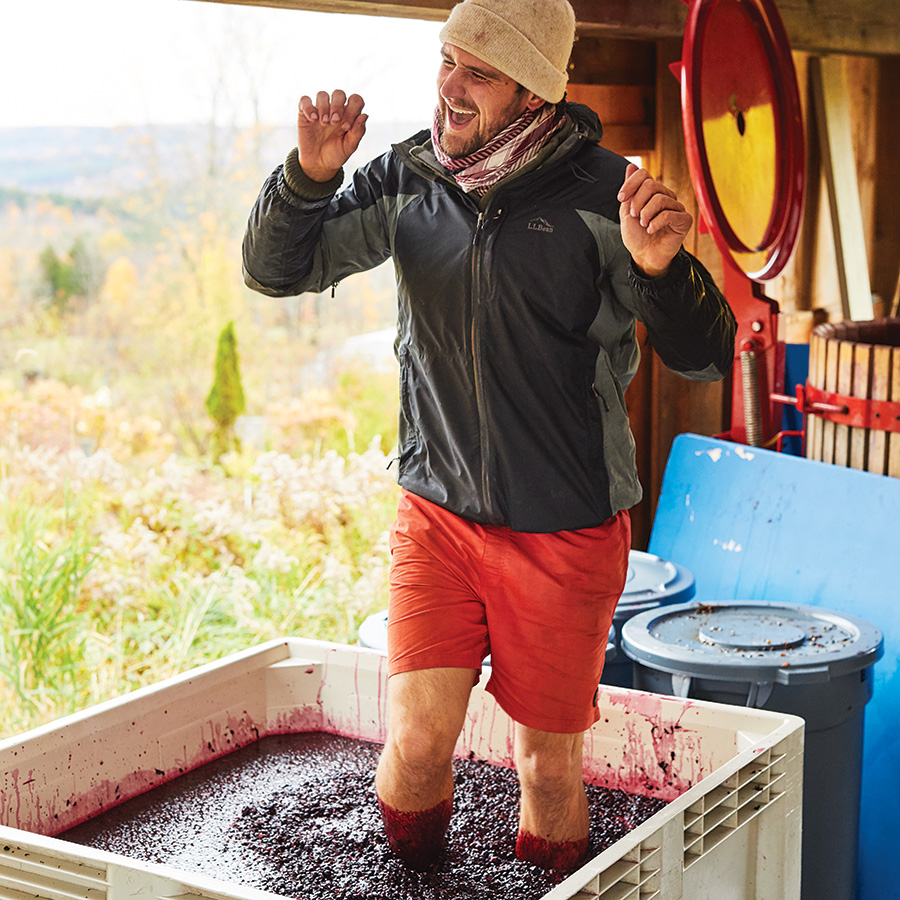
Scenes from the making of La Garagista natural wines in Vermont. / Photo by Pat Piasecki
A day after picking grapes at the vineyard, I found myself at Heekin’s tiny winery near her home, standing barefoot and knee-deep in a vat of purple goop, pumping my legs and trying not to slip. Producing natural wine means forgoing machine crushing for pre-industrial-era, human-powered stomping. “Move around vigorously enough that all the berries burst, but not so vigorously that you splash,” advised Heekin, pointing accusingly to a fresh splatter on the wall. I reined in my vigor and kept stomping, grapes popping beneath my toes, while Heekin, a Botticelli-blond blur in muck boots, continued her lap around the winery, directing apprentices, de-stemming freshly picked fruit, and tasting the juice to check the levels of sugars, acids, and tannins in the grapes and determine which kind of wine should be made from each batch.
It was Heekin’s palate that led her to natural wine. While running the wine program at Vermont’s Pane e Salute, a restaurant she owned with her husband, Caleb Barber, her tastes ran toward small, indie vintners producing natural wines that were elegant, expressive, and very good with food—wines, in other words, that were out of step with the heavy, industrial bottles that dominated in the United States. For all the talk about terroir, the secret truth is that most wine is made in a lab. It’s filtered, blanketed with sulfites to kill any native yeast or other microbes, fermented with an introduced yeast selected for the particular flavors it will impart, run through machines to adjust the level of alcohol, and doctored with additives to enhance the flavor and color. It can have a dozen ingredients—though you can’t tell, since alcohol producers aren’t required to list them on the label—not to mention traces of pesticides. “People are just starting to understand that that pinot noir they get from California tastes the same every year because there’s a shitload of chemicals pumped into it,” says Haley Fortier, the owner of two natural-wine bars in Boston.
Heekin had dreamed for years of making the kind of wine she liked to drink, but, like the rest of us, she’d been led to believe that producing such wines in New England was impossible. You couldn’t blame her. New England has a long tradition of crappy winemaking that stretches right back to the Colonial era. European grapes couldn’t survive New England winters, and American grapes had “foxy” flavors—think: earth and musk—that few serious wine drinkers enjoyed. Breeders crossed European varieties with cold-tolerant American ones, but they never tasted quite right.
In the 2000s, the University of Minnesota began releasing hybrid varieties with somewhat better characteristics, and a new wave of wineries appeared in the northern states, but the wine still wasn’t very good. The hybrids were low in the tannins that give wines such as cabernet bite and complexity, and they were screamingly high in acid. Winemakers doctored them in the cellar to make them more like the opulent California wines that get high ratings, but that just turned them into third-rate versions of California wines.
Part of the problem was that the first generation of northern winemakers were not particularly sophisticated wine drinkers, nor did they know about the natural-wine revolution sweeping Paris. Heekin did, though. A friend in New York who wanted to introduce Heekin to the world of “unaffected wines,” as the vintner calls them, had given her a bottle of Morgon made by Marcel Lapierre, the founding father of the natural-wine movement. “It struck me like a thousand sparkling lights,” she recalls. “It had a clarity and luminescence that was transcendent.”
After that first bottle, Heekin tried many more natural wines while traveling through Europe. By the time she and Barber returned home and walked into a Champlain Valley vineyard in 2007, tasting the new generation of hybrid grapes for the first time, she could perceive something no one else had. “They had balance, they had fruit, they had savory notes,” she wrote in her book, An Unlikely Vineyard. They didn’t have the classic profile of European grapes, but they had lots of interesting character. “All of a sudden, we knew we, too, could grow wine on our little handkerchief of land.”
Heekin bought her first hundred vines that day. Her goals were small. “I just wanted to make a little wine for the restaurant,” she admits. “That’s as far as I thought this would all go.”
Her wines were weird and wonderful, and they were an immediate hit upon their release in 2011. One early champion was natural-wine expert Alice Feiring, though she was initially skeptical. “I definitely thought of hybrids as second-class citizens,” she tells me. Soon, Feiring became a believer and delighted in shocking her fellow wine geeks. “I took a bottle of Deirdre’s wine and put it in a sock and poured it blind for some visiting winemakers from Italy. They all thought it was nebbiolo from the Piedmont. When they found out it was a hybrid from Vermont, they were stunned.”
Within a few years, Heekin had even won over Eric Asimov, the thoughtful and influential New York Times wine critic. “You could make a case that La Garagista is the single most original, creative wine operation in the United States,” he tells me, adding that just about every wine made from European grapes is “largely a knockoff of a European style. But Deirdre is operating with material that nobody else has done anything similar with before. Part of her genius is to let the wine dictate what it’s going to become. That’s really not easy, and it takes a lot of skill.”
In fact, Heekin’s talent has made her a far more important winemaker than her volume of production might imply, Feiring says. “She has such a distinctive voice. It’s completely patient, careful, sensitive winemaking. She truly makes a wine reflective of place. Even if you don’t know where it comes from, you want to go there,” she says, adding without hesitation, “Deirdre is the best winemaker in the United States.”

Scenes from the making of La Garagista natural wines in Vermont. / Photo by Pat Piasecki

Scenes from the making of La Garagista natural wines in Vermont. / Photo by Pat Piasecki
The sign of a true visionary is when the movement overtakes its pioneer. “In the next five to six years,” Feiring predicts, “Vermont is going to become the natural-wine capital of the United States.” After a tasting at Dedalus—the natural-wine bar in Burlington that serves as the town common of the movement in Vermont—with Ethan Joseph and Krista Scruggs, two breakout stars inspired by Heekin, I began to think she was right.
Three years ago, Joseph, the longtime winemaker at the conventionally focused Shelburne Vineyard, launched Iapetus—a natural-wine side label named for the ancient sea whose bedrock underlies the Champlain Valley. “I wanted something that was going to challenge me,” he explained as he poured a bottle of Tectonic, an orange wine made by macerating the juice of white grapes on their skins for 12 weeks to extract oily, resinous notes. Orange wines taste bizarre to anyone used to conventional white wine, in which the grapes are separated from their skins immediately, but it’s how all white wines were made before the mid-20th century, when winemakers began using new industrial equipment to produce simpler, fruitier whites.
Like La Garagista, Iapetus has been a hit since its first vintage in 2016. Joseph said one quarter of Shelburne Vineyards’ production is now devoted to Iapetus, and he expected that number to keep rising. “Vermont’s really well poised to push the natural-wine movement,” he said. “That’s what all my assistants want to make when they’re doing their own projects.”
It’s definitely the only wine Krista Scruggs would ever make. In a maneuver no one would have believed a mere five years ago, Scruggs moved from California to Vermont to learn the art of natural winemaking. She came specifically to train with Heekin and stayed on to launch Zafa Wines, whose tagline is “Just Fucking Fermented Juice from Responsibly Farmed Living Fruit.” Like Scruggs herself, Zafa wines are in-your-face unconventional, wild-fermented and zingy as hell, and striking enough to have landed Scruggs a spot on Wine Enthusiast’s 2018 “40 Under 40 Tastemakers” list. “There seems no limit to her sustainable and delicious creations,” the magazine wrote.
There also seems no limit to the demand for the natural wines being produced by Scruggs, Heekin, Joseph, and Fable Farm Fermentory, another Vermont breakout hit. Scott Doherty, Dedalus’s general manager, said he has had trouble keeping them on the shelf: “In the past year or so, people have begun to come in seeking them. That’s never happened before.”
Given the success of these hot new Vermont vintners, there’s no reason why winemakers in New Hampshire, Maine, and possibly Massachusetts can’t follow in their footsteps. In fact, they’ve already begun. Oyster River Winegrowers, a natural winery in Warren, Maine, has been making waves using grapes grown in the Pine Tree State and other parts of the Northeast. Meanwhile, one of Heekin’s current assistant winemakers, Nicholas Kimberly, is eyeing land in Marlborough, New Hampshire, to start his own vineyard. “I’m looking at a 10-acre plot,” he told me. “It sits at 1,200 feet, on a big south-facing slope. I think that’s the spot. New Hampshire has all that granitic soil, and some of the best wines in the world come from that type of soil.” His goal? “To make New Hampshire a natural-wine destination the way Deirdre’s made Vermont one.”

A harvester collects grapes that will be turned into La Garagista wine. / Photo by Pat Piasecki
Don’t expect the wine establishment to go down without a fight. It has spent decades successfully training the public to buy into its system—and pay accordingly. Robert Parker, the prominent critic who popularized the 100-point scoring system—and whose tastes run toward the opulent and powerful—has called natural wine a “scam.” The New Yorker’s Troy Patterson recently attempted a full takedown of orange wine, which he called “an assault on pleasure. A wine with a finish like sucking on a grapefruit rind is not a wine to drink for enjoyment. It is a wine to suffer through.” Jay Rayner, an English wine critic, compared natural wine to the “whacking smell of a pigsty before it’s been cleaned down, an acrid, grim burst of acid that makes you want to cry.”
These are all common knocks—albeit very colorful ones—on natural wines, which are often made in a range of rule-breaking styles, from astringent orange wines to pétillant naturels, or pét-nats, that are bottled and capped before the wine has finished fermenting. They are generally unfiltered, fermented with wild yeast, and bottled with minimal sulfites, which can make them funky or harsh and, frustratingly for some, inconsistent. In the hands of a not-so-great winemaker, they can actually taste pretty bad.
Critics insist the excitement around natural wines is a passing trend or, worse, a bizarre cult. The anger generated among some, however, suggests a battle that’s less about the taste of natural wine than about who gets to determine what good taste—writ large—even is. “Natural winemakers piss on a thousand years of history,” former longtime San Francisco Chronicle wine critic Jon Bonné once said. It’s “as though a millennium of cultural work is somehow irrelevant because it’s uncool.”
I get where the old guard is coming from. Having spent a great deal of time and money over the years getting up to speed on wine arcana, with its appellations and classification systems and hierarchies, I’ve felt the consternation of drinking with 30-year-olds who consider all the wines I know irrelevant. I can also understand it from the traditional winemaker’s point of view. The idea that some upstart in some unheralded region is making cloudy, funky wine that might be more interesting—and valuable—than yours is deeply troubling. It must be like what a classical painter of France’s Académie des Beaux-Arts felt in the 1870s, watching the public go crazy for Monet and Cézanne, even though they’d been excluded from the official salons.
But this is more than just a case of sour grapes. For California, there’s money at stake. Lots of it. Those Napa Valley vineyards won’t keep selling for $300,000 an acre if nobody likes the wine anymore. Meanwhile, it isn’t only a shift in taste that is putting California at a disadvantage to New England; it’s also climate change. Days with a heat index over 100 degrees cook grapes into something more appropriate for Smucker’s than $3,000 bottles of Screaming Eagle. Historically, Napa has averaged two such days per year. By midcentury, it will average 15. The sweet spot, climate-wise, is moving north and east. California’s loss could well be New England’s gain.
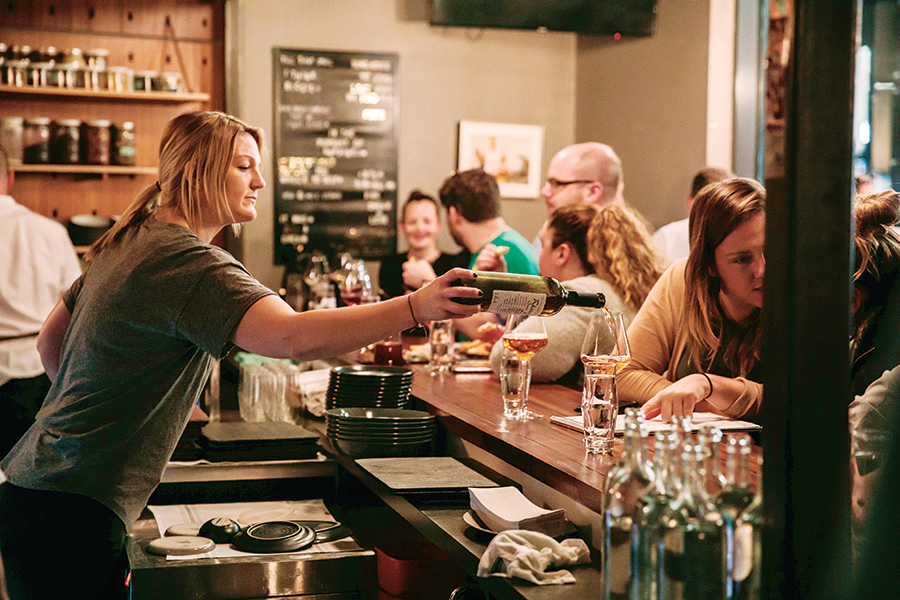
Haley.Henry is one of a handful of natural-wine bars that have opened in recent years. / Photo by Brian Samuels Photography
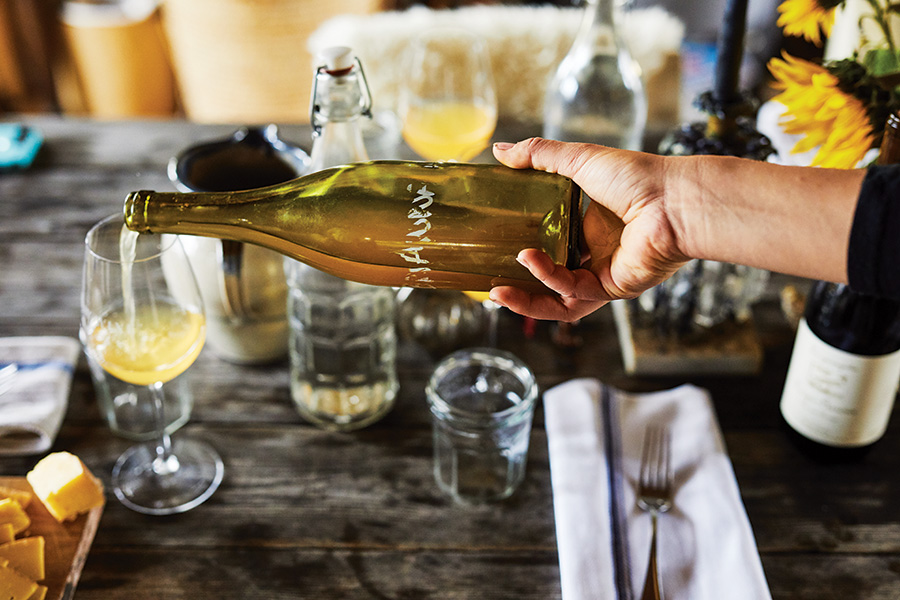
Haley.Henry is one of a handful of natural-wine bars that have opened in recent years. / Photo by Pat Piasecki
It took only an hour seated in the Haley.Henry natural-wine bar, steps from the graves of John Hancock, Samuel Adams, and Paul Revere, to sense the energy in the wine world shifting. On a recent Wednesday night, soon after quitting time, millennials began to crowd into this chic sliver of a bar, where retro rap music thrummed and the wine menu featured such categories as “funky town,” “bold and badass,” and “rare, red, and ridiculous.”
When Haley.Henry opened in 2016, few people in Boston had heard of natural wine. Only Tasting Counter in Somerville was well known for serving it. Now Rebel Rebel in Somerville and Curio Wine in Cambridge have joined the natural-wine uprising. Ken Oringer and Jamie Bissonnette’s Central Square restaurant Little Donkey recently switched its entire wine menu to a natural- and small-producer selection. “There are a lot of really awesome wine bars opening,” Haley.Henry’s owner and sommelier, Haley Fortier, told me, adding that she doesn’t mind the competition at all. “It’s healthy. It verifies everything I thought.” Further verification came this year when Food & Wine named Fortier one of its sommeliers of the year. Fortier recently opened her second bar, Nathálie, which celebrates female winemakers, in the Fenway. “At first, we struggled to try to get people to drink something they’d never had before,” she explained. “But now, half the people who come in don’t even look at the menu. They just say, ‘Pour me something wild and wacky that I’m not going to forget.’”
Two naked light bulbs dangled over a corner table where Elijah Labay and his wife, Julia Radick, both young dancers in town performing with Les Ballets Jazz de Montréal, were being served their first glass of the evening, a natural orange wine. As Radick took her first sip, a look of disappointment came over her face. “I don’t like it,” she told her server, shaking her head.
“Okay, let’s go with something less on the weird side,” the server responded.
Labay, however, found the lightness of the wine perfect for his first glass. Radick was game to sample something else. Both of them say that is what they are after: the adventure of trying something new. “My parents go out and they always have kind of the same thing, a red that is heavy, with lots of legs,” Labay said. “People in our generation are more open to trying new things. We always want that boutique store experience. We don’t just want the steak-and-wine, Union Club experience, if you get what I mean.”
Radick said that while she likes some of the orange wines that are hugely popular with her generation, her parents find them too sour, too yeasty. But then again, that’s not so surprising. “Our generation likes kombucha; my parents don’t,” Labay said, shrugging. “The wine industry is trying to adapt to our generation.”
That night, I noticed that there were no Zafa or La Garagista labels on the shelves. After all, when the new bottles arrive, they tend not to stick around too long. “We just had Before Sunrise on the list here,” Fortier said of one of Scruggs’s wines. “It was literally like getting smacked across the face by a bag of cranberries…We let people buy it by the half-glass so there was less commitment. I just really wanted people to experience it and understand what it was. The response was incredible. People were coming in and asking for it. They were traveling to Boston specifically to get it. It was gone in two weeks.”
Part of the reason our acclaimed local wines are so hard to come by is that, for now, production in New England is tiny. Scruggs, though, is actively trying to increase hers and believes that partnering with academia for land and resources can further the industry in the state. “The University of Vermont has the opportunity to be the UC Davis of the East Coast,” she says, referring to the school whose researchers helped make California’s wine industry what it is today.
What New England lacks in production, though, it makes up for in reputation, potential, and even branding. While California does make quite a few natural wines, its conventional production is so massive that its natural wines will always be relegated to the obscure margins. Because our region has no wine legacy, however, it offers a clean slate that can be claimed by natural winemakers. As a result, it is New England that is poised to lead what could be nothing short of an American revolution in wine. Perhaps that should surprise none of us: After all, revolutions are something we come by naturally.
